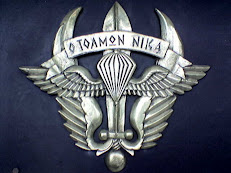 Στις 14 Φεβρουαρίου ολοκληρώθηκε η συνεκπαίδευση της 31ης ΜΕΕΔ με την 37th Airlift Squadron της USAF, η οποία για το σκοπό αυτό μεταστάθμευσε τρία αεροσκάφη C-130J στην Α.Β. Ελευσίνας. Πέραν της 31ης ΜΕΕΔ στη συνεκπαίδευση με την επωνυμία «Stolen Cerberus II» συμμετείχε και το 865ο ΤΕΝΕΦ, σε αντικείμενα συνεργασίας και ρίψης από τα C-130J ελαφρών, μέσων και βαρέων φορτίων.
Στις 14 Φεβρουαρίου ολοκληρώθηκε η συνεκπαίδευση της 31ης ΜΕΕΔ με την 37th Airlift Squadron της USAF, η οποία για το σκοπό αυτό μεταστάθμευσε τρία αεροσκάφη C-130J στην Α.Β. Ελευσίνας. Πέραν της 31ης ΜΕΕΔ στη συνεκπαίδευση με την επωνυμία «Stolen Cerberus II» συμμετείχε και το 865ο ΤΕΝΕΦ, σε αντικείμενα συνεργασίας και ρίψης από τα C-130J ελαφρών, μέσων και βαρέων φορτίων.
e-amyna.
U.S. Air Force Fact Sheet
USAF HUMANITARIAN EFFORTS IN BOSNIA-HERZEGOVINA
"Throughout this bloody conflict, Sarajevo remained a symbolic reminder of UN resolve to achieve peace in the region thanks to the efforts of professional flight crews and ground crews of the U.S. Air Force." - Gen. Ronald R. Fogleman, Chief of Staff, USAF, March 1996 As communism collapsed and the Cold War ended, the Germans tore down the Berlin Wall and reunited, but in the Balkans, nationalism led to civil war and the horrors of "ethnic cleansing." When Slovenia and Croatia declared their independence from Serbian-dominated Yugoslavia, the Serbians fought to maintain control. To keep the fighting from spreading, the United Nations imposed an arms embargo and mediated a cease-fire. In Bosnia-Herzegovina -- home to Bosniacs (Muslims), Croats and Serbians -- the issue became more complex. Bosniac voters in Bosnia overwhelmingly voted for independence from Yugoslavia in early 1992. The Bosnian Serbs boycotted the vote and formed their own government. Meanwhile, the Bosnian Croats formed their own government. Vicious fighting between the three factions soon erupted into the Bosnian Civil War. On March 3, armed citizens -- Serbs on one side and Bosniacs on the other -- erected barricades around Sarajevo. The UN arms embargo prevented the Bosniacs from obtaining weapons, but the Bosnian Serbs received heavy weapons from the Serbian-controlled Yugoslavian army. Better armed, Bosnian Serb forces quickly took control over 60 percent of Bosnia-Herzegovina and encircled Sarajevo. In response, the UN imposed economic sanctions against Serbia and sent peacekeepers into Bosnia to aid the delivery of humanitarian relief. With the roads to Sarajevo controlled by the Bosnian Serbs, airlift became the only way for humanitarian supplies to reach the 380,000 inhabitants of the besieged city. The multinational UN humanitarian airlift, Operation Provide Promise began with the arrival of a French C-130 at Sarajevo airport on July 2, 1992, and it continued for three-and-a-half more years -- three times longer than the Berlin Airlift. The USAF played a major role, starting when the first American C-130 flew into Sarajevo on July 3. Augmented by Active Duty, Air National Guard and Air Force Reserve units from the United States Air Forces in Europe provided food, medicine and other relief supplies to Sarajevo and other areas throughout Bosnia-Herzegovina. In remote areas, the airlifters airdropped supplies. Continued Serbian resistance to humanitarian efforts forced the UN to establish "no-fly" zones over Bosnia and to launch air strikes. Adding to the pressure on the Bosnian Serbs, the United States mediated an agreement between the Bosniacs, the Bosnian Croats and the Government of Croatia to form a federation of Bosniacs and Croats. This agreement ended the fighting between those factions. Nevertheless, the Bosnian Serbs remained belligerent and fired on aircraft flying humanitarian Operation Provide Promise flights. One Italian transport was shot down, and the crew was killed. When it became too dangerous to land at Sarajevo Airport, the airlifters airdropped supplies. At the insistence of the United States, NATO undertook an intensive, month-long bombing campaign in August 1995. Combined with an all-out peace effort by the United States, these airstrikes produced the desired effect. A cease-fire went into effect in October, and peace talks began at Wright-Patterson Air Force Base, Ohio, on Nov. 1, 1995. These negotiations produced the framework for peace known as the Dayton Peace Accords. Operation Provide Promise continued until Jan. 9, 1996. On that date, the last USAF C-130 brought relief supplies into Sarajevo Airport, and 10 minutes later, a French C-130 landed with the ceremonial last pallet of supplies. Although some supplies slipped in through a secret tunnel under Sarajevo Airport, airlift operations allowed Sarajevo to survive until the peace process could work. During the three-and-a-half year operation, the 21 nations supporting Provide Promise flew 12,895 supply missions (4,197 by USAF) and delivered 160,536 metric tons (62,801.5 by USAF) of humanitarian goods to Sarajevo. In addition, the USAF airlifters flew more than 2,200 airdrop sorties across Bosnia.
Fighting in Bosnia-Herzegovina ended in October 1995, and peace talks began at Wright-Patterson Air Force Base outside Dayton, Ohio, on Nov. 1. Twenty days later, on Nov. 21, the negotiators initialed the General Framework Agreement for Peace in Bosnia and Herzegovina -- better known as the "Dayton Peace Agreement," or just "Dayton." On Dec. 14, representatives from all involved nations, including the United States, signed the peace treaty in Paris, France. The Dayton Peace Agreement created a new sovereign state known as the Republic of Bosnia and Herzegovina, and it consisted of two entities: the Bosnian Serb Republic (Republika Srpska) and the Federation of Bosnia and Herzegovina [the Federation of Muslims (sometimes referred to as "Bosniacs") and Croats]. Eleven annexes covered a broad range of issues including military aspects, boundary lines, democratic elections, human rights police forces and de-mining efforts. | ||||||||||||||||||||||||||||||||||||||








































